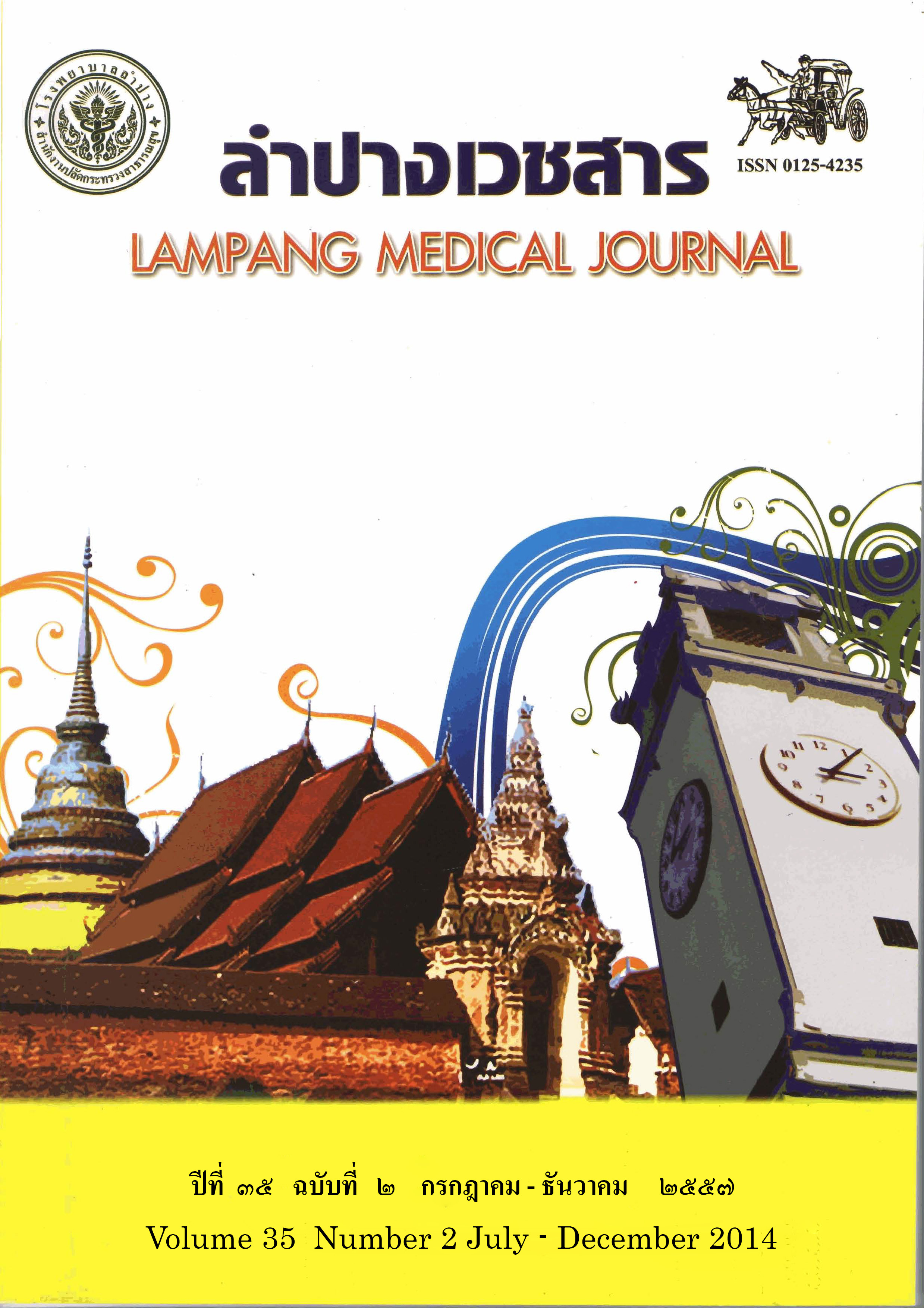Diagnostic Efficacy of Fine Needle Aspiration Cytology for Breast Mass in Lampang Hospital
Main Article Content
Abstract
Background: Fine needle aspiration cytology (FNAC) of the breast lesion was widely adopted for the pathologic assessment. Variation in its accuracy among institutes still remained. There was no previous study about the FNAC efficacy in Lampang Hospital.
Objective: To assess the efficacy of breast FNAC in Lampang Hospital.
Material and method: Patients who had FNAC for breast masses and subsequent histological studies during January 2008-December 2012 were retrospectively reviewed. Cytological diagnoses were classified according to five-tier system and compared to the histological diagnoses. Diagnostic performances of FNAC were assessed.
Results: A series of 795 FNAC results were identified. Among these, 98.2% were female and the mean age was 52.8 ± 11.9 years (range, 17- 94). The FNAC diagnoses were benign lesions in 33.7%, unsatisfactory in 27.4% and malignant in 19.1%. The correlated histological studies were available in 534 cases (67.2%). Diagnostic performances of FNAC for breast lesion were as follows: sensitivity 84.6%, specificity 97.7%, positive predictive value 98.5%, negative predictive value 78.0% and diagnostic accuracy 89.3%. False positive and false negative rate were 2.3% and 15.4% respectively.
Conclusion: The efficacy of FNAC in Lampang Hospital was high and appropriate for initial assessment of breast mass. Correlation with the clinical evaluation and radiological result should be considered for planning of treatment
Article Details

This work is licensed under a Creative Commons Attribution-NonCommercial-NoDerivatives 4.0 International License.
บทความที่ส่งมาลงพิมพ์ต้องไม่เคยพิมพ์หรือกำลังได้รับการพิจารณาตีพิมพ์ในวารสารอื่น เนื้อหาในบทความต้องเป็นผลงานของผู้นิพนธ์เอง ไม่ได้ลอกเลียนหรือตัดทอนจากบทความอื่น โดยไม่ได้รับอนุญาตหรือไม่ได้อ้างอิงอย่างเหมาะสม การแก้ไขหรือให้ข้อมูลเพิ่มเติมแก่กองบรรณาธิการ จะต้องเสร็จสิ้นเป็นที่เรียบร้อยก่อนจะได้รับพิจารณาตีพิมพ์ และบทความที่ตีพิมพ์แล้วเป็นสมบัติ ของลำปางเวชสาร
References
สถาบันมะเร็งแห่งชาติ กรมการแพทย์ กระทรวงสาธารณสุข. แนวทางการตรวจวินิจฉัยและรักษาโรคมะเร็งเต้านม. กรุงเทพมหานคร: ชุมนุมสหกรณ์การเกษตรแห่งประเทศไทย; 2550.
Morris KT, Pommier RF, Morris A, Schmidt WA, Beagle G, Alexander PW, et al. Usefulness of the triple test score for palpable breast masses. Arch Surg 2001;136(9):1008-12.
Zakhour H, Wells C. Diagnostic cytopathology of the breast. London:Churchill Livingstone; 1999.
Yu Y-H, Wei W, Liu J-L. Diagnostic value of fine-needle aspiration biopsy for breast mass: a systematic review and meta-analysis. BMC Cancer 2012; 12:41. doi: 10.1186/1471-2407-12-41.
Chaiwun B, Settakorn J, Ya-In C, Wisedmongkol W, Rangdaeng S, Thorner P. Effectiveness of fine-needle aspiration cytology of breast: analysis of 2,375 cases from northern Thailand. Diagn Cytopathol 2002;26(3):201-5.
Patanasakpinyo C. Accuracy of fine needle aspiration of breast masses: analysis of 2,675 cases in Sawanpracharak Hospital. Sawanpracharak Med J 2010;7(2):114-26.
Mendoza P, Lacambra M, Tan PH, Tse GM. Fine needle aspiration cytology of the breast: the nonmalignant categories. Patholog Res Int 2011; 2011:547580. doi: 10.4061/2011/547580.
Lee KR, Foster RS, Papillo JL. Fine needle aspiration of the breast. Importance of the aspirator. Acta Cytol 1987;31(3):281-4.
Brown LA, Coghill SB. Fine needle aspiration cytology of the breast: factors affecting sensitivity. Cytopathology 1991;2(2):67-74.
Zarbo RJ, Howanitz PJ, Bachner P. Interinstitutional comparison of performance in breast fine-needle aspiration cytology. A Q-probe quality indicator study. Arch Pathol Lab Med 1991;115(8):743-50.
Sneige N. Should specimen adequacy be determined by the opinion of the aspirator or by the cells on the slides. Cancer 1997;81(1):3-5.
Rubenchik I, Sneige N, Edeiken B, Samuels B, Fornage B. In search of specimen adequacy in fine-needle aspirates of nonpalpable breast lesions. Am J Clin Pathol 1997;108(1):13-8.
Abati A. To count or not to count? a review of the issue of adequacy in breast FNA. Diagn Cytopathol 1999 ;21(2):142-7.


